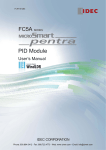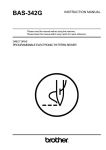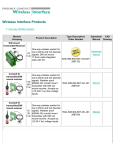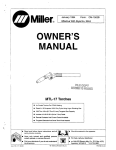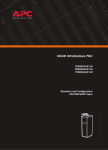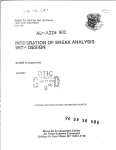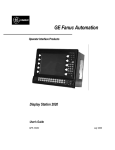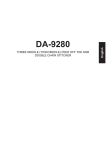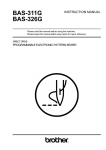Download Brother DA-9270 Instruction manual
Transcript
TWIN NEEDLE (THREE NEEDLE) FEED OFF THE ARM DOUBLE CHAIN STITCHER English DA-9270 DA-9270 Thank you very much for buying a BROTHER sewing machine. Before using your new machine, please read the safety instructions below and the explanations given in the instruction manual. With industrial sewing machines, it is normal to carry out work while positioned directly in front of moving parts such as the needle and thread take-up lever, and consequently there is always a danger of injury that can be caused by these parts. Follow the instructions from training personnel and instructors regarding safe and correct operation before operating the machine so that you will know how to use it correctly. SAFETY INSTRUCTIONS 1. Safety indications and their meanings This instruction manual and the indications and symbols that are used on the machine itself are provided in order to ensure safe operation of this machine and to prevent accidents and injury to yourself or other people. The meanings of these indications and symbols are given below. Indications CAUTION The instructions which follow this term indicate situations where failure to follow the instructions could cause injury when using the machine or physical damage to equipment and surroundings. Symbols ................ This symbol (ٌ) indicates something that you should be careful of. The picture inside the triangle indicates the nature of the caution that must be taken. (For example, the symbol at left means “beware of injury”.) ................ This symbol ( ) indicates something that you must not do. ................ This symbol (٨) indicates something that you must do. The picture inside the circle indicates the nature of the thing that must be done. (For example, the symbol at left means “you must make the ground connection”.) DA-9270 i 2. Notes on safety CAUTION Environmental requirements Use the sewing machine in an area which is free from sources of strong electrical noise such as electrical line noise or static electric noise. Sources of strong electrical noise may cause problems with correct operation. Any fluctuations in the power supply voltage should be within r10% of the rated voltage for the machine. Voltage fluctuations which are greater than this may cause problems with correct operation. The power supply capacity should be greater than the requirements for the sewing machine's power consumption. Insufficient power supply capacity may cause problems with correct operation. The ambient temperature should be within the range of 5qC to 35qC during use. Temperatures which are lower or higher than this may cause problems with correct operation. The relative humidity should be within the range of 45% to 85% during use, and no dew formation should occur in any devices. Excessively dry or humid environments and dew formation may cause problems with correct operation. In the event of an electrical storm, turn off the power and disconnect the power cord from the wall outlet. Lightning may cause problems with correct operation. Installation Machine installation should only be carried out by a qualified technician.ᴾ Contact your Brother dealer or a qualified electrician for any electrical work that may need to be done. The sewing machine weighs approximately 49 kg. The installation should be carried out by two or more people. Do not connect the power cord until installation is complete, otherwise the machine may operate if the treadle is pressed by mistake, which could result in injury.ᴾ Be sure to connect the ground. If the ground connection is not secure, you run a high risk of receiving a serious electric shock, and problems with correct operation may also occur. ii DA-9270 All cords should be secured at least 25 mm away from any moving parts. Furthermore, do not excessively bend the cords or secure them too firmly with staples. If this is not observed, fire or electric shocks may result. If using a work table which has casters, the casters should be secured in such a way so that they cannot move. Be sure to wear protective goggles and gloves when handling the lubricating oil, so that it does not get into your eyes or onto your skin. If care is not taken, inflammation can result. Furthermore, do not drink the lubricating oil. Diarrhea or vomiting may result. Keep the oil out of the reach of children. CAUTION Sewing This sewing machine should only be used by operators who have received the necessary training in safe use beforehand. If using a work table which has casters, the casters should be secured in such a way so that they cannot move. The sewing machine should not be used for any applications other than sewing. Attach all safety devices before using the sewing machine. If the machine is used without these devices attached, injury may result. Be sure to wear protective goggles when using the machine. If goggles are not worn, there is the danger that if a needle breaks, parts of the broken needle may enter your eyes and injury may result. Turn off the power switch at the following times. However, the motor will keep turning even after the power is switched off as a result of the motor’s inertia. Wait until the motor stops fully before starting work. The machine may operate if the treadle is depressed by mistake, which could result in injury. Do not touch any of the moving parts or press any objects against the machine while sewing, as this may result in personal injury or damage to the machine. If an error occurs in machine operation, or if abnormal noises or smells are noticed, immediately turn off the power switch. Then contact your nearest Brother dealer or a qualified technician. If the machine develops a problem, contact your nearest Brother dealer or a qualified technician. x When threading the needle x When replacing the needle x When not using the machine and when leaving the machine unattended Cleaning Turn off the power switch before carrying out cleaning. However, the motor will keep turning even after the power is switched off as a result of the motor’s inertia. Wait until the motor stops fully before starting work. The machine may operate if the treadle is depressed by mistake, which could result in injury. Be sure to wear protective goggles and gloves when handling the lubricating oil, so that it does not get into your eyes or onto your skin. If care is not taken, inflammation can result. Furthermore, do not drink the lubricating oil. Diarrhea or vomiting may result. Keep the oil out of the reach of children. Use only the proper replacement parts as specified by Brother. Maintenance and inspection Maintenance and inspection of the sewing machine should only be carried out by a qualified technician. Ask your Brother dealer or a qualified electrician to carry out any maintenance and inspection of the electrical system. Turn off the power switch and disconnect the power cord from the wall outlet at the following times. However, the motor will keep turning even after the power is switched off as a result of the motor’s inertia. Wait until the motor stops fully before starting work. The machine may operate if the treadle is depressed by mistake, which could result in injury. If the power switch needs to be left on when carrying out some adjustment, be extremely careful to observe all safety precautions. Use only the proper replacement parts as specified by Brother. If any safety devices have been removed, be absolutely sure to re-install them to their original positions and check that they operate correctly before using the machine. Any problems in machine operation which result from unauthorized modifications to the machine will not be covered by the warranty. x When carrying out inspection, adjustment and maintenance x When replacing consumable parts such as the looper DA-9270 iii 3. Warning labels ڎThe following warning labels appear on the sewing machine. Please follow the instructions on the labels at all times when using the machine. If the labels have been removed or are difficult to read, please contact your nearest Brother dealer. 1 2 Be sure to connect the ground. If the ground connection is not secure, you run a high risk of receiving a serious electric shock, and problems with correct operation may also occur. 3 Direction of operation Safety devices: (A) Finger guard (B) Thread take-up cover (C) Pulley cover, etc. <Rear view> 1552B 1551B iv DA-9270 CONTENTS 1. NAMES OF MAJOR PARTS ......1 9. STANDARD ADJUSTMENTS..... 17 2. MACHINE SPECIFICATIONS.....1 9-1. Needle bar height adjustment .......................17 3. TABLE AND MOTOR ................. 9-2. Needle and looper timing adjustment............18 2 9-3. Timing of loopers running clear of needles ...19 3-1. Table processing diagram............................... 2 9-4. Needle guard adjustment ..............................20 3-2. Motor ............................................................... 3 4. INSTALLATION .......................... 9-5. Feed dog height adjustment..........................21 4 9-6. Upper thread take-up guide adjustment ........21 4-1. Installing the machine head ............................ 4 9-7. Adjusting the upper thread guide ..................22 4-2. Ground wire connections ................................ 6 9-8. Tension release shaft adjustment .................22 4-3. Installing the pulley cover................................ 6 9-9. Lower thread take-up timing adjustment .......22 4-4. BeIt tension adjustment .................................. 7 9-10. Installing the lapper .....................................23 4-5. Assembling the cotton stand........................... 7 9-11. Puller height adjustment 4-6. Lubrication....................................................... 8 (Machines with puller)..................................23 4-7. Checking the machine pulley 9-12. Puller timing adjustment rotating direction ............................................. 9 5. PREPARATION BEFORE SEWING.................................... (Machines with puller)..................................23 10. TROUBLESHOOTING .............. 24 10 5-1. Needles and threads..................................... 10 5-2. Installing the needles .................................... 10 5-3. Threading the lower threads ......................... 11 5-4. Threading the upper threads......................... 11 6. SEWING.................................... 12 6-1. Sewing .......................................................... 12 7. THREAD TENSION..................... 13 7-1. Adjusting the thread tension ......................... 13 7-2. Presser foot pressure adjustment ................. 13 7-3. Adjusting the stitch length ............................. 14 7-4. Puller feed adjustment (Machines with puller) ................................... 14 8. CLEANING .................................. 16 8-1. Daily cleaning................................................ 16 8-2. Changing the lubricating oil (every three months)..................................... 16 DA-9270 1. NAMES OF MAJOR PARTS㩷 㩷 2. MACHINE SPECIFICATIONS㩷 㩷 㩷 1. NAMES OF MAJOR PARTS 1553B (1) Machine pulley (2) Front cover (3) Presser foot (4) Needle bar (5) Upper thread guide (6) Lapper Safety devices (7) Thread take-up cover (8) Finger guard (9) Pulley cover 2. MACHINE SPECIFICATIONS Specifications 1554B Specifications Use DA-9270-1 DA-9270-2 Light-weight materials Max. sewing speed Light-weight to medium-weight materials 4,000 rpm DA-9270-3 DA-9270-A Medium-weight materials Light-weight materials, with puller 3,600 rpm No. of needles 2 2 2 Needle TV x 64 #12 4.8(3/16) 6.4(1/4) #14 #16 4.8(3/16) 6.4(1/4) Needle gauge (mm) Max. stitch length 3.0 mm 3.5 mm Min. arm size 1 171 mm DA-9270 2 3 #11 JLP 4.8(3/16) 6.4(1/4) 6.4(1/4) 3.0 mm 3. TABLE AND MOTOR 3. TABLE AND MOTOR 3-1. Table processing diagram The top of the table should be 40 mm in thickness and should be strong enough to hold the weight and withstand the vibration of the sewing machine. Drill holes as indicated in the illustration below. A: Chain hole B: Motor mounting holes (3 places) C: Cotton stand hole D: Ground hole 1655B DA-9270 2 3. TABLE AND MOTOR㩷 3-2. Motor CAUTION All cords should be secured at least 25 mm away from any moving parts. Furthermore, do not excessively bend the cords or secure them too firmly with staples. If this is not observed, fire or electric shocks may result. Install the correct belt cover which corresponds to the motor being used. <Motor> Select the correct motor from those listed in the table below. Refer to the instruction manual for the motor for details on installing and using the motor. Power Motor Single-phase 2-pole, 400 W motor Three-phase 2-pole, 400 W motor <Motor pulley and V-belt> For details on the relationship between the motor pulleys and belts, refer to the table below. * The belt should be an M-type V-belt. Pulley O.D. 65 70 75 M42 80 85 90 3 100 M43 Belt size Sewing speed (rpm) 95 M44 50Hz 60Hz 3100 3100 3600 3600 4000 DA-9270 4000 4. INSTALLATION㩷 4. INSTALLATION CAUTION Do not connect the power cord until installation is complete, otherwise the machine may operate if the treadle is depressed by mistake, which could result in injury. Machine installation should only be carried out by a qualified technician. Contact your Brother dealer or a qualified electrician for any electrical work that may need to be done. Be sure to connect the ground. If the ground connection is not secure, you run a high risk of receiving a serious electric shock, and problems with correct operation may also occur. The sewing machine weighs approximately 49 kg. The installation should be carried out by two or more people. Install the pulley cover to the machine head. <Cautions regarding table and legs> When installing the legs to the table, adjust the heights of the legs so that the machine head can be set up horizontally. If the machine head is not horizontal, it will adversely affect the lubrication of the needle bar mechanism, and seizing or abnormal wear may occur. 4-1. Installing the machine head 1. Install the pulley cover base (2) on the machine bed (1) with the two hexagonal bolts (3) and two washers (4). 2. Insert the two bar cushions (5) into the holes in the bottom of the bed. <Bottom view> 1467B * Parallel ᐔⴕ When installing the pulley cover base (2), slide the two hexagonal bolts (3) as far as possible into the slots in the pulley cover base (2) and tighten them. Furthermore, check that the pulley cover base (2) is parallel to the bed. (If it is not parallel, the pulley cover may touch the machine pulley.) 1555B DA-9270 4 4. INSTALLATION㩷 3. Place the machine head on the table, adjust its position in forward and backward directions by aligning it with the hole for the presser foot lifter chain (6), and in sidewise directions by aligning it with the belt hole (7). 1556B 4. 5. Install the two mounting plates (8) to the machine bed (1) and the pulley cover base (2) with the two set screws (9). Secure the two collars (10), the four rubber cushions (11) and the two washers (12) to the table with the two screws (13) as shown in the illustration. 1470B 6. Connect the presser foot lifter chain (6) to the knee lifter lever (14) and the foot lifter pedal (15). 1471B 5 DA-9270 4. INSTALLATION㩷 4-2. Ground wire connections Connect the ground wire to the sewing machine head and motor. * Use the correct type of ground wire and washer. 1. Remove the screw (1). 2. Secure the ground wire (2) to the sewing machine head with the screw (1) and washer (3). (The attachment location is indicated by the ground symbol [A].) 3. Pass the ground wire (2) through the hole in the table. 4. Connect the ground wire (2) to the motor in accordance with the instructions in the instruction manual for the motor. To motor 1557B 4-3. Installing the pulley cover 1. Place the belt (2) onto the machine pulley (1). * Pull the belt (2) upward when installing the pulley cover A (3). 1473B 2. Place the pulley cover A (3) so that it is in between the eight pulley cover sheets (4), and then secure it to the pulley cover base with the four screws (5). 1474B 3. Push the belt (2) downward, and then install the pulley cover B (6) to the pulley cover A (3) with the three screws (7). 1475B DA-9270 6 4. INSTALLATION㩷 4. If the machine is being used with the puller attached, install the puller belt cover (8) with the two screws (9). 1476B 4-4. Belt tension adjustment 1. Place the V-belt (3) onto the machine pulley (1) and the motor pulley (2). 2. Turn the nuts (4) to adjust so that there is 20 – 30 mm of deflection in the V-belt (3) when it is pressed at the midway point with a force of 9.8 N. 1477B 4-5. Assembling the cotton stand 1. Assemble the cotton stand while referring to the instruction manual for the cotton stand. 2. Install the cotton stand to the table with the nut (1). 1558B 7 DA-9270 4. INSTALLATION㩷 4-6. Lubrication CAUTION Be sure to wear protective goggles and gloves when handling the lubricating oil, so that it does not get into your eyes or onto your skin. If care is not taken, inflammation can result. Furthermore, do not drink the lubricating oil. Diarrhea or vomiting may result. Keep the oil out of the reach of children. 㨯 The sewing machine should always be lubricated and the oil supply replenished before it is used for the first time, and also after long periods of non-use. 㨯 Use only the lubricating oil (NIPPON OIL CORPORATION Sewing Lube 15N; VG15) specified by Brother. * If this type of lubricating oil is difficult to obtain, the recommended oil to use is Exxon Mobil Essotex SM15, VG15. 1. Open the front cover (1), remove the rubber cap (2), and then fill with oil until the oil level reaches the point in between the upper reference line [A] and the lower reference line [B] on the oil gauge (3). * If the oil level drops to the lower reference line [B], be sure to add more oil. 2. Insert the rubber cap (2) and then close the front cover (1). * * Periodically loosen the oil drain screw (4) to drain out any oil which collects in the front bed oil sump. After draining the oil, tighten the oil drain screw (4). Periodically wipe away any oil which collects in the rear bed oil sump (5) with a cloth. 1559B 3. Turn the machine pulley (6), so that the oil feeding pipe cap (7) is facing upward, and then remove the oil feeding pipe cap (7) and fill the oil tank (8) with oil. * If the level of lubricating oil drops below the middle reference line [C] on the oil tank, no oil will be drawn into the upper shaft, and the upper shaft will thus not be lubricated sufficiently. Be sure to maintain the lubricating oil level at a level above the center reference line [C]. 4. Attach the oil feeding pipe cap (7). 1480B 5. If the machine is being used with the puller attached, remove the screw (9) and fill with oil until the level reaches the upper reference line [D] in the oil sight glass. * If the oil level drops to the lower reference line [E], be sure to add more oil. After lubrication is completed, tighten the screw (9). 1481B DA-9270 8 4. INSTALLATION㩷 6. Remove the rubber cap (10). 7. Turn the machine pulley until the needle bar (11) is raised to the highest position. 8. Add 2-3 drops oil to the needle bar from the hole from which the rubber cap (10) was removed. 9. Insert the rubber cap (10). 10. Add 1-2 drops of oil to the needle bar bush lubrication hole (12). * Add 1-2 drops of oil to the needle bar bush lubrication hole (12) once a week. 1560B 4-7. Checking the machine pulley rotating direction CAUTION Do not touch any of the moving parts or place any objects against the machine while sewing machine is operating, as this may result in personal injury or damage to the machine. 1. Insert the power cord plug into the wall outlet, and then turn on the power switch. 2. Depress the treadle slightly and check that the machine pulley (1) starts to turn in the direction of the arrow [A]. * If the direction of rotation is reversed, change the direction of rotation to the correct direction while referring to the instruction manual for the motor. * For the first 3 - 4 days of use, run the machine at 500 rpm lower than the usual speed. This will help contribute to a longer service life for the machine. 1483B 9 DA-9270 5. PREPARATION BEFORE SEWING㩷 5. PREPARATION BEFORE SEWING 5-1. Needles and threads The needle and threads to be used vary depending on sewing conditions. Select the correct ones by referring to the table below. Thread Needle TV×64 Upper thread Lower thread #11 spun yarn #80 spun yarn #80 #12 #14 spun yarn #60 spun yarn #60 #16 spun yarn #50 spun yarn #50 5-2. Installing the needles CAUTION Turn off the power switch before installing the needle. However, the motor will keep turning even after the power is switched off as a result of the motor’s inertia. Wait until the motor stops fully before starting work. The machine may operate if the treadle is depressed by mistake, which could result in injury. 1. Turn the machine pulley until needle clamp (1) is raised to the highest position. 2. Loosen the two set screws (2), hold the two needles (3) with their long grooved side facing front, insert them into the needle clamp (1) all the way, and fasten the needle with the two set screws (2). 1561B DA-9270 10 5. PREPARATION BEFORE SEWING㩷 5-3. Threading the lower threads CAUTION Turn off the power switch before threading the lower thread. However, the motor will keep turning even after the power is switched off as a result of the motor’s inertia. Wait until the motor stops fully before starting work. The machine may operate if the treadle is depressed by mistake, which could result in injury. 1562B 1563B Needle hole position 1487B 1564B 1489B 5-4. Threading the upper threads CAUTION Turn off the power switch before threading the upper thread. However, the motor will keep turning even after the power is switched off as a result of the motor’s inertia. Wait until the motor stops fully before starting work. The machine may operate if the treadle is depressed by mistake, which could result in injury. 1565B 11 1491B DA-9270 6. SEWING㩷 6. SEWING CAUTION Attach all safety devices before using the sewing machine. If the machine is used without these devices attached, injury may result. Turn off the power switch at the following times. However, the motor will keep turning even after the power is switched off as a result of the motor’s inertia. Wait until the motor stops fully before starting work. The machine may operate if the treadle is depressed by mistake, which could result in injury. 㨯 When threading the needle 㨯 When replacing the needle 㨯 When not using the machine and when leaving the machine unattended Do not touch any of the moving parts or place any objects against the machine while sewing, as this may result in personal injury or damage to the machine. 6-1. Sewing 1. Turn on the power switch. 2. Depress the foot lifter pedal (1) and place the work under the presser foot. 3. Release the foot lifter pedal (1). 4. The machine starts running when the treadle (2) is stepped down. 1492B 5. After sewing the work, move the work to the thread trimmer (3) to make blank stitches, and cut the thread with it. 1493B DA-9270 12 7. THREAD TENSION㩷 7. THREAD TENSION 7-1. Adjusting the thread tension Upper thread Good stitches Lower thread Upper thread Lower thread Loose, bad stitches Appearance of seam when upper thread tension is too weak 1494B Becomes weaker Becomes stronger 1. Adjust the upper thread tension properly by turning the tension nut (1). 2. Adjust the lower thread tension properly by turning the tension nut (2). Becomes stronger Becomes weaker 1566B 7-2. Presser foot pressure adjustment Adjust the presser foot pressure by turning presser adjust screw (1) so that the pressure is just enough to feed the work positively and keep the work from slipping. * If the machine is being used with the puller attached, depending on works, the puller pressure can be adjusted as appropriate to the work by turning the presser adjust screw (2). Becomes Becomes weaker stronger Becomes stronger Becomes weaker 1567B 13 DA-9270 7. THREAD TENSION㩷 7-3. Adjusting the stitch length CAUTION Turn off the power switch before adjusting the stitch length. However, the motor will keep turning even after the power is switched off as a result of the motor’s inertia. Wait until the motor stops fully before starting work. The machine may operate if the treadle is depressed by mistake, which could result in injury. The numerals on the machine pulley scale represent the stitch length (mm), however the actual stitch length will vary depending on the type and thickness of material being used. 1. Open the front cover (1). 2. While pressing the feed adjustment button (2), turn the machine pulley (3) toward you slowly. * The feed adjustment button (2) will move further inward. 3. While still pressing the feed adjustment button (2), keep turning the machine pulley (3) until the desired numeral appears in the center of the pulley cover windows (4). * The higher the value of the numeral, the larger the stitch length becomes. 4. Release the feed adjustment button (2). * Check that the feed adjustment button (2) pops back out again. 5. Adjust the needle guard. (Refer to “9-4. Needle guard adjustment”.) 6. Close the front cover (1). NOTE: Do not press the feed adjustment button (2) while the 1568B machine is operating, as doing so may damage the machine parts. Be sure to adjust the needle guard after changing the stitch length. If you use the sewing machine without adjusting the needle guard, skipped stitches may occur or the looper tip may become broken. 7-4. Puller feed adjustment (Machines with puller) 1. With the feed adjusting button (1) lightly pressed with your finger, turn the machine pulley toward yourself until the feed adjusting button (1) goes in one step deeper. 2. Keep pressing the feed adjusting button (1), and turn the machine pulley to set your desired feed position on the scale to the reference line [A]. * The more you turn the machine pulley toward yourself, the smaller the feed will be. * Adjust the puller feed after seeing the finished stitches of the work (Refer to the next page). Smaller Larger 1498B DA-9270 14 7. THREAD TENSION㩷 The table below shows samples of stitches made with a highly elastic fabric and a fabric which is not so elastic. Adjust the puller feed by referring to this table. Puller feed Fabric with high elasticity Fabric with low elasticity 1500B 1499B Correct Feed direction Neither non-alignment nor sewing wrinkles. Feed direction Neither non-alignment nor sewing wrinkles. 1501B 1502B Insufficient Non-aligned, and wrinkled. Non-aligned, and wrinkled. 1503B 1504B Excessive Non-aligned, and very wavy. 15 DA-9270 Non-aligned, and very wavy. 8. CLEANING㩷 8. CLEANING The following cleaning operations should be carried out each day in order to maintain the performance of this machine and to ensure a long service life. Furthermore, if the sewing machine has not been used for a long period of time, carry out the following cleaning procedures before using it again. CAUTION Turn off the power switch before carrying out cleaning. The motor will keep turning even after the power is switched off as a result of the motor’s inertia. Wait until the motor stops fully before starting work. The machine may operate if the treadle is depressed by mistake, which could result in injury. Be sure to wear protective goggles and gloves when handling the lubricating oil, so that it does not get into your eyes or onto your skin. If care is not taken, inflammation can result. Furthermore, do not drink the lubricating oil. Diarrhea or vomiting may result. Keep the oil out of the reach of children. 8-1. Daily cleaning Cleaning the machine 1. Open the looper cover (1) and clean away any thread scraps and other rubbish. 2. After cleaning, close the looper cover (1). Lubrication Refer to “4-6. Lubrication”. 1505B Checking 1. Check that the threads are threaded correctly. (Refer to “5-3. Threading the lower threads”, and “5-4. Threading the upper threads”.) 2. If the tips of the needles are broken, replace the broken needles. 3. Carry out a trial sewing. 8-2. Changing the lubricating oil (every three months) 1569B The lubricating oil should be changed at least once every three months. 1. Remove the eleven screws (1), and then open the forward feed arm cover (2). 2. Draw up all of the lubricating oil inside the machine into the oil bottle (3). 3. Fill the machine with oil until the oil level reaches the point in between the upper and lower reference lines on the oil gauge. (Refer to “4-6. Lubrication”.) 4. Close the forward feed arm cover (2) and secure it with the eleven screws (1). [Machines with puller] 1. Remove the eight screws (4), and then open the puller top cover (5). 2. Draw up all of the lubricating oil inside the machine into the oil bottle (3). 3. Fill the machine with oil until oil level reaches the upper reference line [A] in the oil sight glass (6). (Refer to “4-6. Lubrication”.) 4. Close the puller top cover (5) and secure it with the eight screws (4). 1507B DA-9270 16 9. STANDARD ADJUSTMENTS㩷 9. STANDARD ADJUSTMENTS CAUTION Maintenance and inspection of the sewing machine should only be carried out by qualified personnel. Ask your Brother dealer or a qualified electrician to carry out any maintenance and inspection of the electrical system. Turn off the power switch and disconnect the power cord from the wall outlet at the following times. However, the motor will keep turning even after the power is switched off as a result of the motor’s inertia. Wait until the motor stops fully before starting work. The machine may operate if the treadle is depressed by mistake, which could result in injury. x When carrying out inspection, adjustment and maintenance x When replacing consumable parts such as the looper If any safety devices have been removed, be absolutely sure to re-install them to their original positions and check that they operate correctly before using the machine. 9-1. Needle bar height adjustment 1570B Adjust the heights of the needles (1). At this time, adjust so that each needle (1) is in the center of the needle hole (3) in the needle plate (2). 1. Remove the screw (4), and then remove the presser foot (5). 2. Turn the machine pulley to drop the needle bar to its lowest position. For light-weight materials (-1 and -A specifications) and light-weight to medium-weight materials (-2 specifications): 11.3 mm For medium-weight materials (-3 specifications): 10.3 mm 1575B 1509B 1572B 17 3. Remove the rubber cap (6). 4. Loosen the screw (8) and adjust so that the distance from the bottom of the needle clamp (7) to the top of the needle plate (2) is as follows. For light-weight materials (-1 and -A specifications) and light-weight to medium-weight materials (-2 specifications): 11.3 mm For medium-weight materials (-3 specifications): 10.3 mm * Check that the distance from the tip of the needle to the top of the needle plate (2) is as follows when the needle clamp (7) is at its highest position. For light-weight materials (-1 and -A specifications) and light-weight to medium-weight materials (-2 specifications): 8.5 mm For medium-weight materials (-3 specifications): 10.7 mm 5. Remove the three screws (9), and then remove the needle plate (2). 6. Turn the machine pulley so that the needles (1) and the needle guard (10) are aligned, and then adjust the tilt of the needle clamp (7) so that there is no space between the left and right needles (1) and the needle guard (10) at this time. 7. Install the needle plate (2) with the three screws (9), and after checking that the needles (1) are in the centers of the needle holes (3), tighten the screw (8). 8. Insert the rubber cap (6). 9. Install the presser foot (5) with the screw (4). 1573B DA-9270 9. STANDARD ADJUSTMENTS㩷 9-2. Needle and looper timing adjustment Adjust so that the looper (2) is at the end of its backward travel and so that the distance from the center of the needle (1) to the tip of the looper (2) is 2.1 to 2.3 mm when the needle (1) is at its lowest position. 1579B 1574B For light-weight materials (-1 and -A specifications) and light-weight to medium-weight materials (-2 specifications): For medium-weight materials (-3 specifications) 1576B 1575B For light-weight materials (-1 and -A specifications) and light-weight to medium-weight materials (-2 specifications): <Looper forward travel> <Looper backward travel> 1. Remove the presser foot, needle plate and feed dogs (Refer to “9-1. Needle bar height adjustment”.) 2. Remove the two screws (3), and then open the belt cover plate (4). 3. Turn the machine pulley (5) toward yourself until loopers (2) reach the end of their backward travel. 4. Loosen the two screws (6) and move the looper holder (7) in the arrow direction until the distance between the needle (1) center and the looper (2) tip is 2.1 to 2.3 mm, and retighten the two screws (6) securely. 5. Loosen cap screw (8), and then loosen two set screws (10) on lower belt wheel (9). 6. Turn the machine pulley (5) toward you to move the needle (1) up and down, and check that the loopers (2) and the needle (1) are described below. For light-weight materials (-1 and -A specifications) and light-weight to medium-weight materials (-2 specifications): The needle holes of the looper (2) should be aligned with the center of the needle hole both when the looper (2) moves to the left from the start of its forward travel and when it moves to the right from the start of its backward travel. For medium-weight materials (-3 specifications): The needle height when the looper (2) moves to the right from the start of its backward travel until the tip of the looper (2) is aligned with the middle of the needle (1) should be 0.7 to 1.3 mm lower than the needle height when the looper (2) moves to the left from the start of its forward travel until the tip of the looper (2) is aligned with the middle of the needle (1). * If adjustment is necessary, hold the looper (2) so that it does not move, and then turn the machine pulley (5) to make the adjustment. * If adjustment is not possible, repeat the adjustment from step 4, or check the needle height. (Refer to “9-1. Needle bar height adjustment”.) 7. Tighten the two set screws (10) securely, and then tighten the cap screw (8). 8. Close the belt cover plate (4), and then tighten the two screws (3). 9. Install the presser foot, needle plate and feed dogs. 1577B For medium-weight materials (-3 specifications): <Looper backward travel> <Looper forward travel> 1578B DA-9270 18 9. STANDARD ADJUSTMENTS㩷 9-3. Timing of loopers running clear of needles 1517B Turning direction Set screw at the rear Set screw at the front 1519B For light-weight materials (-1 and -A specifications) and light-weight to medium-weight materials (-2 specifications) 1580B For medium-weight materials (-3 specifications) 1581B 1582B For light-weight materials (-1 and -A specifications) and light-weight to medium-weight materials (-2 specifications) For medium-weight materials (-3 specifications) The loopers (1) run in back of the needles (2) in their forward travel and in front of the needles (2) in their backward travel. Adjust so that the clearance between the needle (2) and the looper (1) at this time is 0.05 to 0.1 mm during forward travel. 1. Remove forward feed arm cover (3). 2. Adjust so that the forward/back timing for the looper is as follows. For light-weight materials (-1 and -A specifications) and light-weight to medium-weight materials (-2 specifications): Adjust so that the set screw at the front of the looper oscillating cam relative to the turning direction is aligned with the adjustment hole (5) in the looper connecting rod when the set screw at the front of the looper forward/back cam relative to the turning direction is aligned with the adjustment hole (4) in the cam sleeve. * To adjust, loosen the set screw which is at the rear of the looper forward/back cam relative to the turning direction, and then loosen the set screw at the front just enough so that the looper forward/back cam can be adjusted. For medium-weight materials (-3 specifications): Adjust so that the set screw at the rear of the looper oscillating cam relative to the turning direction is positioned forward of the adjustment hole (5) in the looper connecting rod and is no longer visible in the hole when the set screw at the rear relative to the forward/back cam turning direction is aligned with the adjustment hole (4) in the cam sleeve. * To adjust, loosen the set screw which is at the front relative to the forward/back cam turning direction, and then loosen the set screw at the rear just enough so that the forward/back cam can be adjusted. 3. After adjusting, tighten the two set screws. 4. Loosen the screw (6) and move the looper holder (7) in the direction of the arrow to adjust so that the clearance is 0.05 to 0.1 mm when the tip of the looper (1) is aligned with the middle of the needle (2). NOTE: At this time, do not move the looper holder (7) in any direction except the direction indicated by the arrow. If it is moved in another direction, carry out the adjustments given in “9-2. Needle and looper timing adjustment”. 5. Install the forward feed arm cover (3). 1583B 19 DA-9270 9. STANDARD ADJUSTMENTS㩷 9-4. Needle guard adjustment 1584B For movable needle guard Adjust the needle guard (2) so that the clearance between the needle guard (2) and the needle (1) is 0.2 mm when the stitch length is set to the minimum length and the looper moves forward to reach the needle (1). 1. Set the stitch length to the minimum length. (Refer to “7-3. Adjusting the stitch length.”) 2. Turn the machine pulley toward you to set the looper so that its tip is aligned with the middle of the needle (1). 3. Loosen the set screw (3), and then move the needle guard (2) up or down to adjust so that the distance from the bottom of the needle guard (2) to the tip of the needle (1) is 1 to 2 mm. 4. Tighten the set screw (3). 5. Loosen the set screw (4), and then move the needle guard (2) to the left or right to adjust so that the clearance between the needle guard (2) and the needle (1) is 0.2 mm. 6. Tighten the set screw (4). NOTE: Depending on the type of material and thread being used, good results may be obtained if the needle guard is adjusted so that it slightly touches the needle when the stitch length is set to the actual length to be used. 1585B 1586B For fixed needle guard This prevents the needle (1) from touching the looper when the looper is moving forward. Install the needle guard (2) so that it is as close to the needle (1) as possible without actually touching it. 1. Turn the machine pulley toward you to move the needle (1) to its lowest position. 2. Loosen the screw (3) at the bottom of the forward feed arm. 3. Move the needle guard (2) to adjust so that the clearance between the needle (1) and the needle guard (2) is 0.2 to 0.3 mm. 4. After adjusting, securely tighten the set screw (3). 1587B DA-9270 20 9. STANDARD ADJUSTMENTS㩷 9-5. Feed dog height adjustment Make an adjustment so that the highest part of the feed dog (1) will be 0.8 mm above the top surface of the needle plate (2) when the feed dog (1) is at the highest position. Adjust the height of the feed dog (1) by turning the feed bar eccentric shaft (3). 1588B 9-6. Upper thread take-up guide adjustment Adjust the distance between the center of the upper thread take-up hole (1) and the top of the upper thread take-up guide (2) will be 2 - 4 mm. 1. Turn the machine pulley toward yourself until the needle bar is down at the lowest position. 2. Loosen the screw (3), and then move the upper thread take-up guide (2) up or down to adjust so that the distance from the top of the upper thread take-up guide (2) to the center of the upper thread take-up hole (1) is 2 - 4 mm. * The higher the upper thread take-up guide (2) positions, the greater the upper thread loops will be. 3. Tighten the screw (3). 1589B 21 DA-9270 9. STANDARD ADJUSTMENTS㩷 9-7. Adjusting the upper thread guide The upper thread guide should be adjusted so that the upper thread is being pulled slightly when the looper releases the upper thread loop. Thread should be horizontal 1. Turn the machine pulley toward you to move the needle to its highest position. 2. Loosen the screw (1), and then adjust the upper thread guide (2) so that the upper thread is almost horizontal from the upper thread guide (2) to the upper thread take-up (3). 3. After adjusting, tighten the screw (1). 1590B 9-8. Tension release shaft adjustment Adjust the tension release shaft so that the tension discs loosen when the presser foot is raised and tighten when the presser foot is lowered. 1. Loosen set screw (1). 2. Make an adjustment by turning the tension release shaft (2) so that the tension discs begin to loosen when the presser foot rises 4 mm above the top of the needle plate. 3. After the adjustment, retighten the set screw (1) securely. 1591B 9-9. Lower thread take-up timing adjustment Adjust so that the lower thread take-up (1) touches the thread (2) and is raised 7 mm above the lower thread take-up base (3) when the looper starts moving backward. 1. Insert the screwdriver through the adjusting hole [A] in the lower thread take-up base (3), and loosen the two set screws (4). 2. Turn the machine pulley toward you until the looper is at the start of its backward travel. 3. Raise the lower thread take-up (1) until it is 7 mm up from the thread take-up base (3). 4. After the adjustment, retighten the two set screws (4) securely. 1592B DA-9270 22 9. STANDARD ADJUSTMENTS㩷 9-10. Installing the lapper Insert the lapper guide plate from the front into the oval slot in the forward feed arm cover, making sure that the end of the lapper is clear of the presser foot. Lapper adjustment Loosen the screw (1) to adjust the overlapping width [A] of the front welt seam. After adjusting, tighten the screw (1). Loosen the two screws (2) to adjust the overlapping width [B] of the rear welt seam. After adjusting, tighten the two screws (2). 1534B 1535B 9-11. Puller height adjustment (Machines with puller) Adjust the height of the puller (1) so that it is 0.4 to 0.5 mm high from the top of the needle plate (2). Loosen the screw (3), and move the puller support (4) up or down until the puller (1) is 0.4 to 0.5 mm above the top of the needle plate (2). After the adjustment, retighten the screw (3). 1593B 9-12. Puller timing adjustment (Machines with puller) Make an adjustment so that, when the needle bar is down at the lowest position, the mark [A] on the timing collar (1) is in line with the reference line [B]. 1. Turn the machine pulley toward yourself until the mark [A] on the timing collar (1) meets the reference line [B]. 2. Loosen the two set screws (2), and turn the machine pulley toward yourself until the needle bar is lowered all the way down. 3. Retighten the two set screws (2). 1536B 23 DA-9270 10. TROUBLESHOOTING 10. TROUBLESHOOTING x If there is a problem with operation, first check that the threads are correctly threaded and that the needle is correctly installed. x Please check the following points before calling for repairs or service. x If the following remedies do not fix the problem, turn off the power switch and consult a qualified technician or the place of purchase. CAUTION Turn off the power switch and disconnect the power cord from the wall outlet before carrying out troubleshooting. The motor will keep turning even after the power is switched off as a result of the motor’s inertia. Wait until the motor stops fully before starting work. The machine may operate if the treadle is depressed by mistake, which could result in injury. Problem Cause 1. Upper thread is not tight. 2. Skipped stitches occur while sewing 1541B 3. Seam position is incorrect. (Machines with puller) 4. Machine does not feed work. Remedy Page The upper thread tension is too weak. Adjust the upper thread tension. 13 The lower thread tension is too strong. Adjust the lower thread tension. 13 The position of the upper thread take-up guide is incorrect. Adjust the upper thread take-up guide position correctly. 21 The needle is not properly installed.! Install the needle correctly. 10 The looper points are dull. Replace the loopers with good ones. 18 The needle and looper timing is incorrect. Adjust the needle and looper timing correctly. 18 The clearance between the needles and loopers are incorrect. Adjust the clearance between the needles and loopers correctly. 18 The lower thread take-up timing is incorrect.! Adjust the lower thread take-up timing correctly.! 22 The puller timing is incorrect.! Adjust the puller timing.! 23 The puller feed is incorrect. Adjust the puller feed. 14 The presser foot pressure is incorrect. Adjust the presser foot pressure. 13 The feed dog height is incorrect. Adjust the feed dog height. 21 The feed dog is too low. Adjust the feed dog height. 21 The presser foot pressure is too small. Adjust the presser foot pressure. 13 The feed dog is worn out. Have serviceman check it. 㧙 The presser foot floats and does not fully press work. Have serviceman check it. 㧙 The feed dog and presser foot work on one side only. Have serviceman check it. 㧙 DA-9270 24 10. TROUBLESHOOTING㩷 Problem Cause 5. Upper and lower threads are breaking. 1542B 6. Broken needles Remedy Page The needle is bent or the needle tip is broken. Replace the needle. 10 The needle is not properly installed. Install the needle correctly. 10 The needle is not properly threaded.! Thread the needle correctly.! 11 The upper or lower thread tension is too weak or too strong.! Adjust the upper thread or lower thread tension.! 13 The position of the tension release shaft is incorrect. Adjust the position of the tension release shaft correctly. 22 The needle holes are too small for threads.! Check the needle and thread counts.! 10 The loopers are damaged.! Smooth the loopers with an oiled grindstone or replace the damaged parts.! 18 The material is being pushed or pulled with excessive force during sewing.! Do not push or pull the material with excessive force. 㧙 The needle is not properly installed. Install the needle correctly. 10 The needle tip is bent. Replace the needle. 10 The needle tip is broken, or the needle hole is blocked. Replace the needle. 10 Needles hit the loopers. Adjust the timing of the loopers running clear of the needles. 19 The needle is touching the needle guard. (For fixed needle guard) Adjust the needle guard. 20 The needle holes are too small for threads. Check the needle and thread counts. 10 CAUTION: It is extremely dangerous to leave any pieces of broken needle sticking in the material. If the needle breaks, search for all pieces until the whole of the needle is found again. Furthermore, we recommend that thorough steps be taken to account for such needles to comply with product liability regulations. 1543B 25 DA-9270 ขᛒ⺑ᦠ INSTRUCTION MANUAL Г᧲▐ᇨ̰ MANUAL DE INSTRUCCIONES http://www.brother.co.jp/ http://www.brother.com/ Printed in Japan / ᇈኈ ׂڊ/ Impreso en Japón DA-9270 SA9517-001 2008.03. B (1)


































